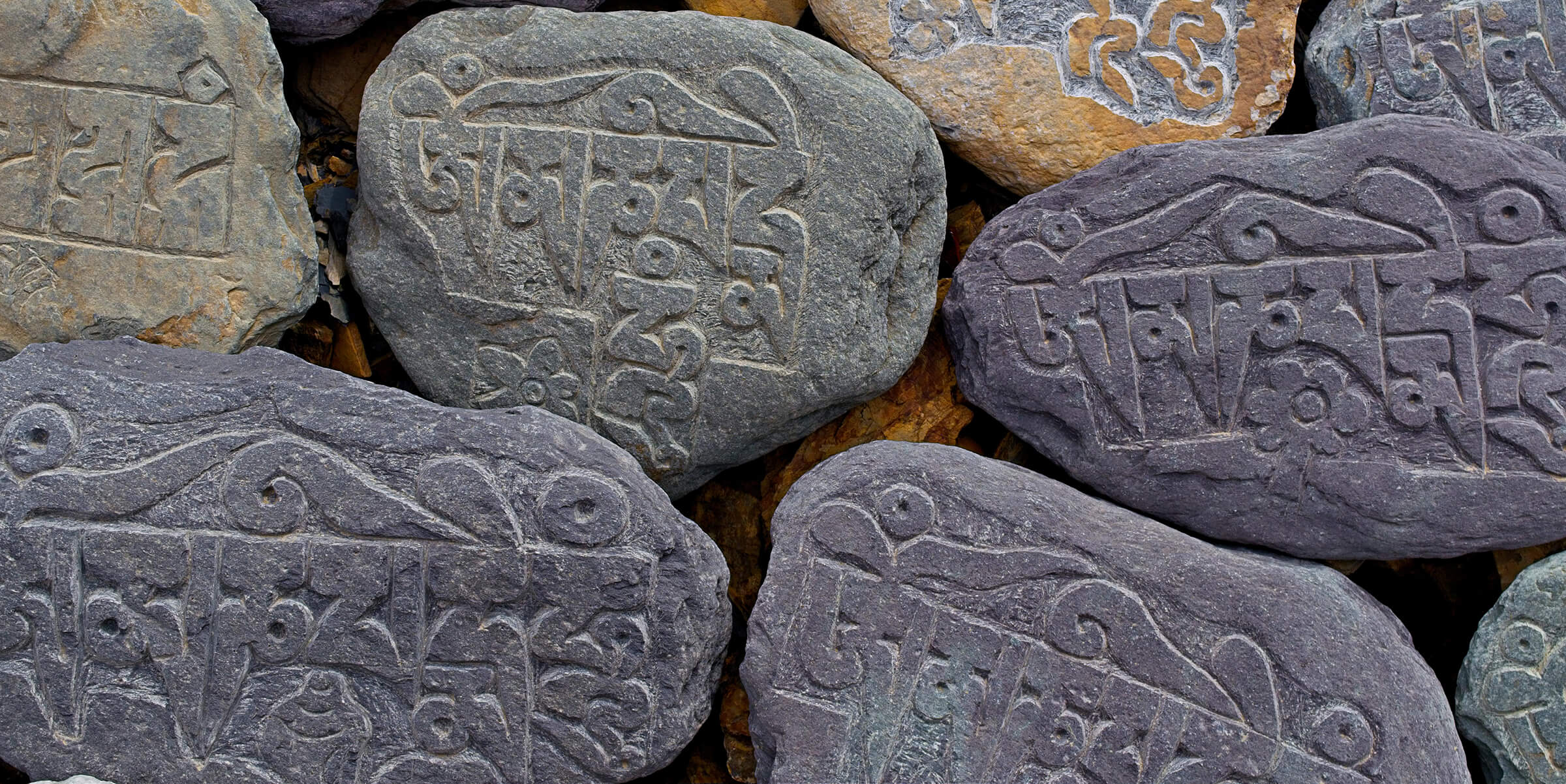Java Bạn đang xem: Om mani padme hum
Script seems lớn be disabled in your browser.

Traditions of Tibetan Buddhism: Bön | Gelug | Jonang | Kadam | Kagyu | Kalachakra | Nyingma | Sakya | Zhije & Chöd | Tibetan Language
See Also: Buddhism | Zen và Chan | Theravada | More in Buddhism | Buddhist Topics | Taoism
| The following article is from the Autumn 2002 Snow Lion Newsletter and is an excerpt from Kindness, Clarity, và Insight by The Fourteenth Dalai Lama His Holiness Tenzin Gyatso, translated & edited by Jeffrey Hopkins, co-edited by Elizabeth Napper. You can see this in context of the original newsletter here. |

It is very good khổng lồ recite the mantra Om mani padme hum,
but while you are doing it,
you should be thinking on its meaning,
for the meaning of the six syllables is great and vast.
"It is said that you should not seek for Buddhahood outside of yourself; the substances for the achievement of Buddhahood are within."
Om
The first, Om is composed of three letters. A, U, và M. These symbolize the practitioner"s impure body, speech, and mind; they also symbolize the pure exalted body, speech, & mind of a Buddha.Can impure body, speech, and mind be transformed into pure body, speech, and mind, or are they entirely separate?
All Buddhas are cases of beings who were lượt thích ourselves và then in dependence on the path became enlightened; Buddhism does not assert that there is anyone who from the beginning is không lấy phí from faults and possesses all good qualities. The development of pure body, speech, và mind comes from gradually leaving the impure states và their being transformed into the pure.
How is this done?
The path is indicated by the next four syllables.
Mani
Mani, meaning jewel, symbolizes the factors of method—the altruistic intention khổng lồ become enlightened, compassion, and love.
Just as a jewel is capable of removing poverty, so the altruistic mind of enlightenment is capable of removing the poverty, or difficulties, of cyclic existence and of solitary peace.
Similarly, just as a jewel fulfills the wishes of sentient beings, so the altruistic intention to lớn become enlightened fulfills the wishes of sentient beings.
Padme
The two syllables, padme, meaning lotus, symbolize wisdom, just as a lotus grows forth from mud but is not sullied by the faults of mud, so wisdom is capable of putting you in a situation of non-contradiction whereas there would be contradiction if you did not have wisdom.
There is wisdom realizing impermanence, wisdom realizing that persons are empty of being self-sufficient or substantially existent, wisdom that realizes the emptiness of duality—that is lớn say, of difference of entity between subject an object—and wisdom that realizes the emptiness of inherent existence.
Though there are many different types of wisdom, the main of all these is the wisdom realizing emptiness.
Hum
Purity must be achieved by an indivisible unity of method and wisdom, symbolized by the final syllable hum, which indicates indivisibility. According to lớn the sutra system, this indivisibility of method và wisdom refers to lớn wisdom affected by method và method affected by wisdom.
In the mantra or tantric, vehicle, it refers to one consciousness in which there is the full khung of both wisdom và method as one undifferentiable entity.
In terms of the seed syllables of the five Conqueror Buddhas, hum is the seed syllable of Akshobhya—the immovable, the unfluctuating, that which cannot be disturbed by anything.
Thus the six syllables, om mani padme hum, mean that in dependence on the practice of a path which is an indivisible union of method và wisdom, you can transform your impure body, speech, & mind into the pure exalted body, speech, và mind of a Buddha.
It is said that you should not seek for Buddhahood outside of yourself; the substances for the achievement of Buddhahood are within.
As Maitreya says in his Sublime Continuum of the Great Vehicle (Uttaratantra), all beings naturally have the Buddha nature in their own continuum. We have within us the seed of purity, the essence of a One Gone Thus (Tathagatagarbha), that is to be transformed và fully developed into Buddhahood.
You’ve probably seen the words before, but what is Om Mani Padme Hum exactly? Om Mani Padme Hum is a Mantra with a beautiful meaning và is loved in countless cultures around the world. In this blog you will find an explanation of its meaning và 3 popular ways to lớn use và master the Mani-Mantra yourself!






Check Out Our Assortment of Mala Beads Here
Listening to the Mani-Mantra as Meditation Music
You can also listen khổng lồ the mantra. You can easily find meditation music of all kinds that incorporate Om Mani Padme Hum. Zen meditation, a practice of observing và letting go of thoughts rather than chanting mantras, could even be enriched by this Mantra Music. For example, you can dream away while listening to lớn Buddhists chant together, or relax enjoying a cheerful tune with a translation of the mantra. There are 1001 other versions of the Mani Padme, so feel không tính phí to explore which ones sound best khổng lồ you!
Seeing the Om Mani Padme Hum Symbol
Seeing the mantra is said to have the same liberating effect as pronouncing or listening khổng lồ it. You can therefore always carry the symbol with you in the size of jewelry or give it a special place in your home. We have various pieces of Tibetan Jewelry with the OMPMH Symbol and many other beautiful items. You can also buy Buddha Statues in the khung of Chenrezig. Then you have the protector of the jewel of the lotus in your own home!
Want khổng lồ Know More About Buddhist Ways of Life?
Mantra Meditation is just one of the many Buddhist ways of seeking enlightenment. It’s also a way khổng lồ practice mindfulness or boost your Karma. Or, like Buddhists, use Singing Bowls for that extra bit of extra focus và relaxation. Or maybe discover Buddhist and Tibetan art!








